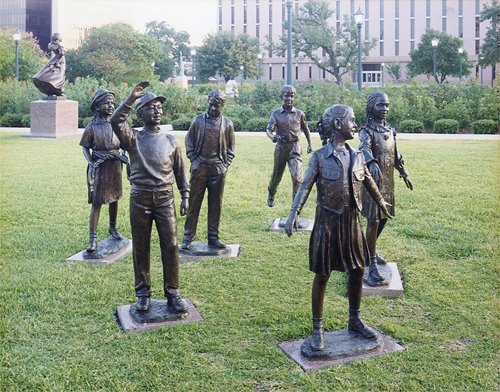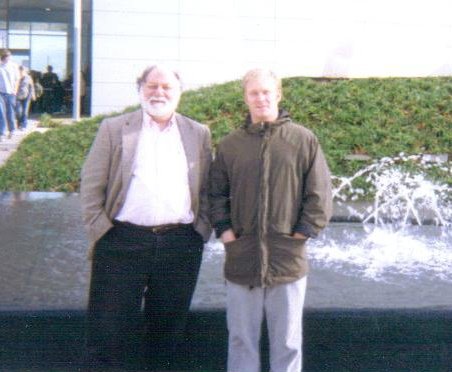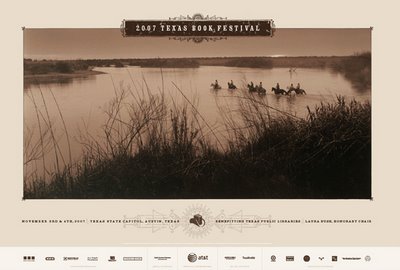From the Texas Administrative Code, read and learn 4th grade 7th grade |
10/30/2009
Bullock Texas State History Museum Teaching Aids
Educators may visit the Bullock Museum for assistance.http://www.thestoryoftexas.com/education/educators.html
K - 12th Grade Teachers Home School Teachers Adult ESL Educators Star Educator E-newsletter |
10/24/2009
LC American Memory Collections
American Memories is a section of webpage by the Library of Congress. Searching for "Texas" one finds 250 pages of items, each page with 15 items, and 250 is the maximum number of pages retrievable. So Texas likely has far in excess of 5,000 items. Can so be useful for schools. What items? Photographs, maps, sheet music, architecture, books, laws, just all sorts of things - graphically depicted !!! The items are mostly from the LC, but other institutions contribute, e.g., UT-Austin. In all probability your town has material there, maybe dozens, maybe hundreds. Topics are broad. American Memories has bluebonnets, armadillos, longhorns, etc. Go see !! http://memory.loc.gov/ammem/index.html You can search by place - lotsa hits for Dallas, Galveston, Houston, and of course my hometown of Marshall, and my places of education Jacksonville, Nacogodoches, Kingsville, and Austin. You can browse by time period.. You can also browse by topic
|
10/23/2009
Texas History (with Primary Sources 1997) Marrou
ERIC at http://www.eric.ed.gov/ notes this decade old introduction (ERIC 428996). Somebody should find it interesting to obtain a copy and compare it to opportunities today. Texas History: Teaching with Primary Source Series. By Judy Marrou and Patti Woolery-Price. Peterborough, NH: Cobblestone Publishing Company, 1997. 192 pages. It's abstract reads: "Intended to be used by teachers of grades 5 and up, this unit deals with Texas. The unit is built around the seven standards of the new Texas Essential Knowledge and Skills (TEKS), an outcome-based social studies curriculum guide for teaching Texas history. The guide includes the following standards: citizenship, economics, geography, history, government, culture, and science/technology. The activities in the unit are designed around the social studies skills outlined in TEKS. Looking at old photographs, letters, maps, and census records students learn the stories of real people. Students are asked to collect information from several sources and to create visual materials that include maps, timelines, and graphs. The focus is on cooperative problem-solving and decision-making as processes for learning. Activities are provided that allow students to practice the following skills and strategies: collecting, organizing, interpreting, and weighing the significance of factual evidence to achieve a systematic document analysis; comparing and contrasting evidence from different sources; identifying factual information and separating it from opinion; identifying points of view and biases; and developing defensible inferences, conclusions, and generalizations from factual evidence practice. (BT) " |
Texas Slavery Project
| What is it? Self-description: "The Texas Slavery Project takes a deep look at the expansion of slavery in the borderlands between the United States and Mexico in the years between 1837 and 1845. Based at the Virginia Center for Digital History, the project offers a number of digital tools that allow users to explore the changing face of slavery in early Texas ...." Need a some statistics, by area within early Texas, need direction to some primary sources (letters, laws, documents, etc.), need some maps that show distribution of slaves and slave-holders across the years? This is a notable place to come. Torget's self-description: "Andrew J. Torget is the project's founder and director. Andrew is Assistant Professor of History at the University of North Texas, where he is completing a book titled Cotton Empire: Slavery, the Texas Borderlands, and the Origins of the Mexican-American War. Andrew received his Ph.D. from the University of Virginia while serving as the founding director of the Digital Scholarship Lab at the University of Richmond. He is also the co-editor of two books, Crucible of the Civil War: Virginia from Secession to Commemoration (University of Virginia Press, 2006) and Two Communities in the Civil War (W. W. Norton, 2007)." An excellent website substantially derived from the work at the University of Virginia. Does not address slavery among Native Texas tribes or the previous military system or peonage systems among the Spanish and Mexican elite, or the slavery in post-annexation Texas, or the prison labor system conducted by the state in subsequent years.. |
10/21/2009
Antique Maps of Texas - Charlton
Well, pull up a chair and grab a cup of coffee because when you get your copy, you'll be looking and clicking for a spell. This 4th edition of Antique Maps of Texas has over 300 maps. Yessireebob.
CONTENTS: And its arranged into "Great Maps of Texas" 1777-1931, Special Maps (cattle, exploration, military and forts, county, geologic, minerals) US historic 1803-1907, and 9 sections of grouped USGS selected topographic maps. Accompanying each map, Charlton has written a 200-word text on the map, the topic, and / or the cartographer. NAVIGATION; You can flip through the pages as you would a paper book; you can zoom in for a closer look; you can pan by grab and drag; you can bookmark, you can click the 17 tabs set on the right-hand edge, you can use the find button to search the maps' supplementary text Charlton provided. And, hey, look, there's a date and place index in the back. And for those accustomed to passive viewing, you can set the presentation on an auto-flip and watch the page spreads at a variable time span. If you prefer to opt out of the "page" presentation, a side-show option can be invoked. To top it off, Charlton has added period graphics between the sections. Sure enough, the 1902 (the year before my father was born) Century Atlas railroad map shows my father's hometown of Harleton, my mother's hometown of Jefferson, and my hometown of
Charlton's near decade long project is admirable. And while you can certainly use and benefit from this electronic map collection, Charlton also offers you the opportunity to have him supply printed versions. There're fairly good prices. This is a worthy acquisition for citizens, libraries, and social studies teachers. |
10/20/2009
Texas history classroom videos - Jank Williams on Veoh
Jank Williams teaches Texas history to a flock of youngsters. He is an active user of the Veoh video website to load his classroom videos there. The 18 videos (3 - 25 minutes) often feature Williams beside a power point presentation on the day's topic. He joined Veoh about three months ago during the summer. These 18 seem to be his videos to date. His additions across the year will make an intersting and useful source for folks. Certainly his students find it helpful, and others wishing an survey of Texas history will also. Some samples include |





